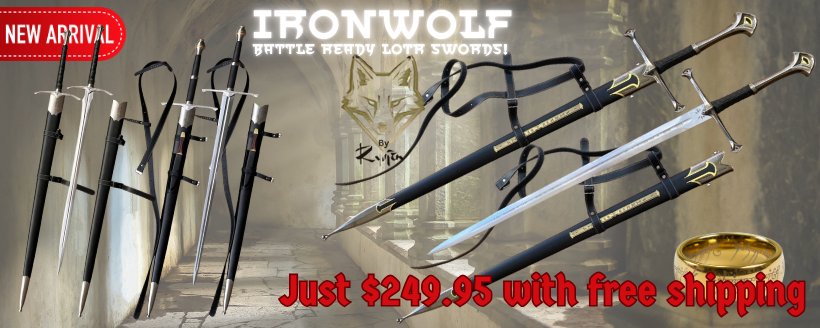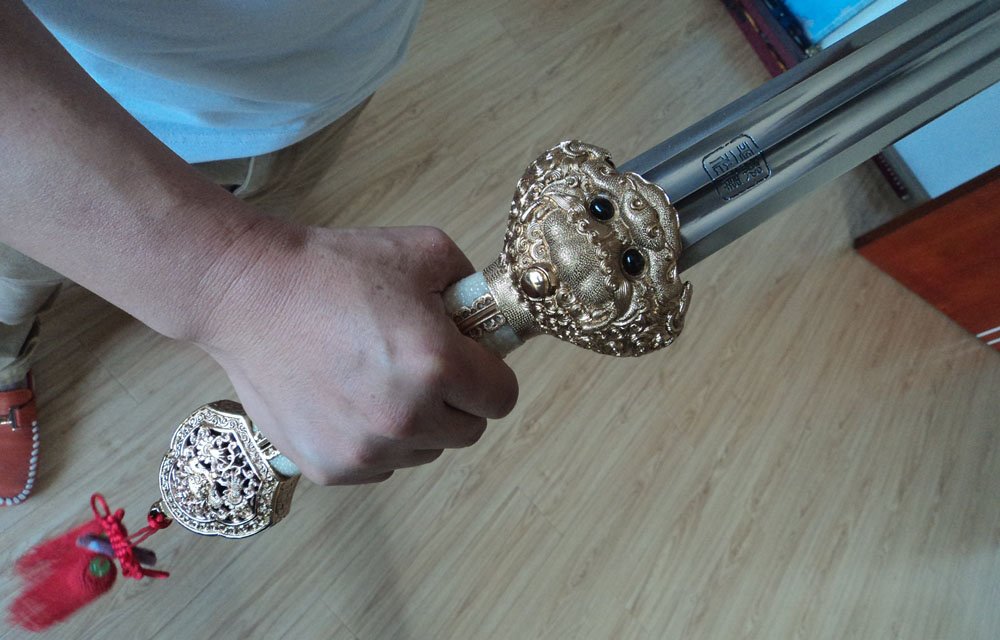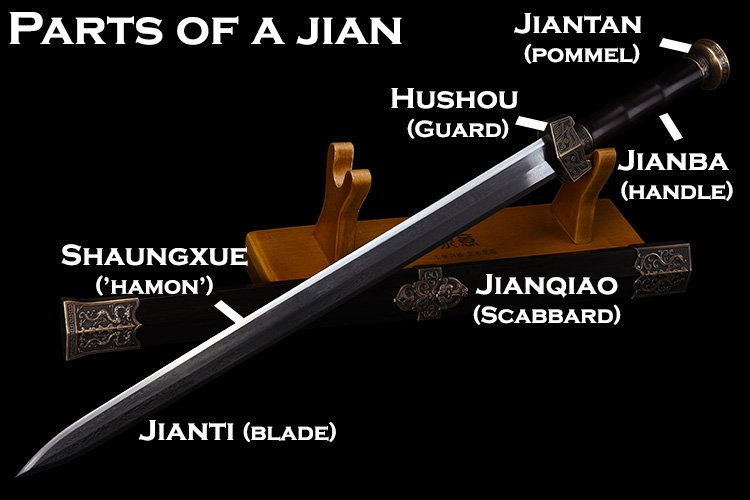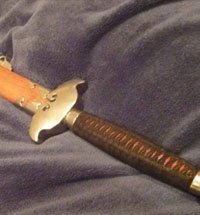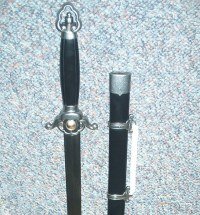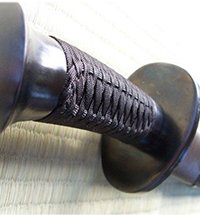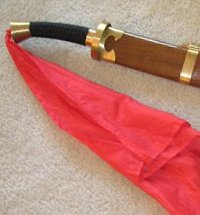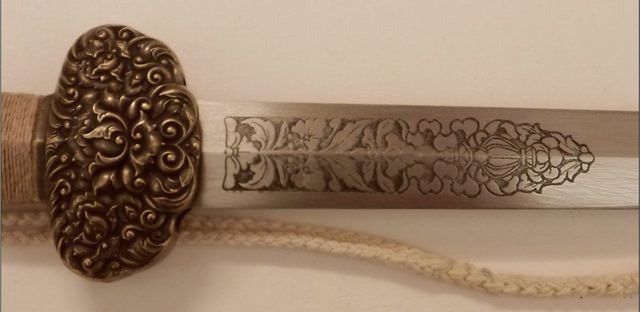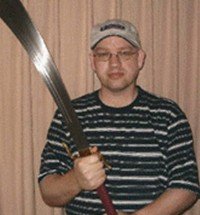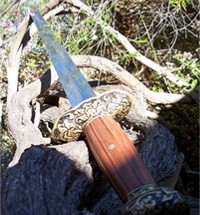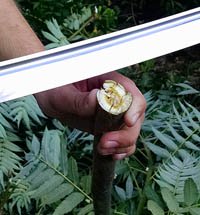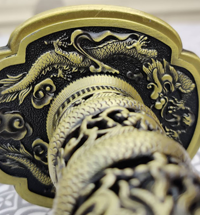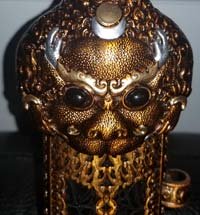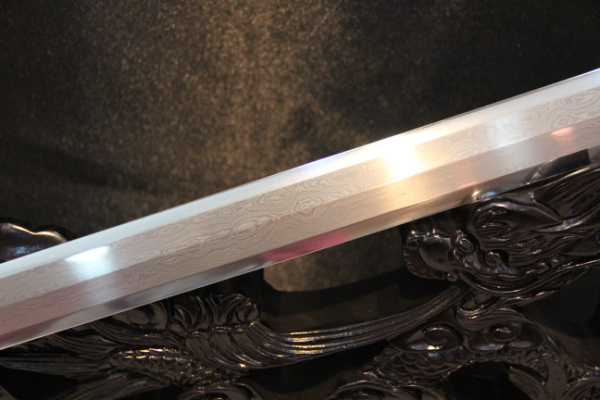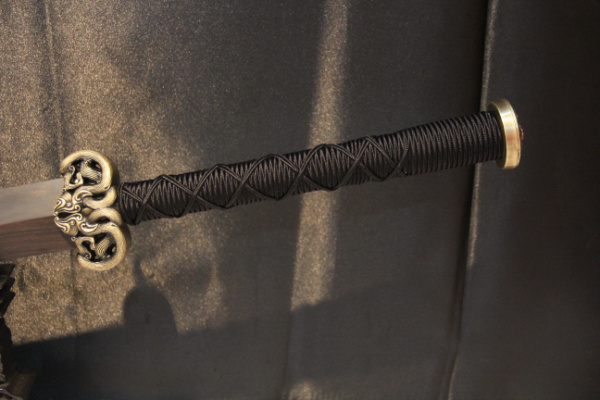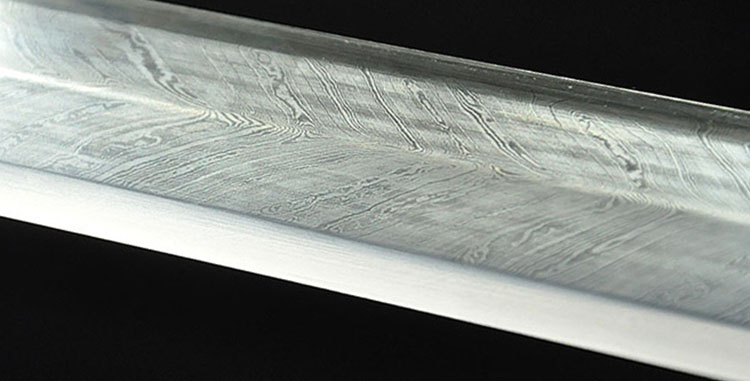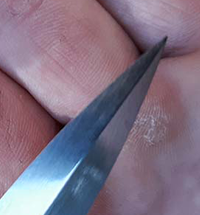Chinese Swords
Chinese swords are relatively unknown in the West - there have not been that many translations of Chinese texts, nor have many western scholars attempted their own independent studies.
This is rather strange when you consider that they were some of the most advanced and technically brilliant swords of their era, branching out from bronze and forging the first steel and iron two handed swords during the warring states period (475-221 B.C.) whose equivalents would arise in the west until 1,000-1,500 years later..
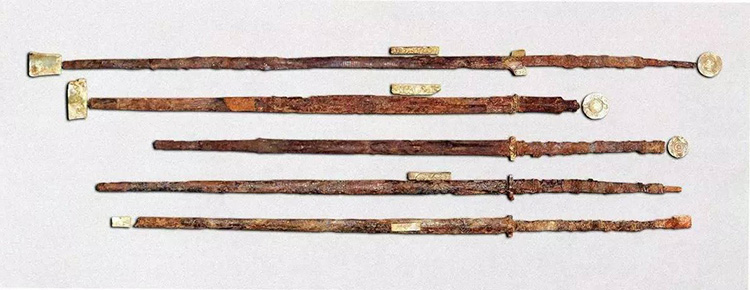 Swords from the Han Dynasty, the longest one is 57" long - such swords were not seen in the west until well over 1000 years later...
Swords from the Han Dynasty, the longest one is 57" long - such swords were not seen in the west until well over 1000 years later...In much the same way that little is known about Chinese Swords outside of China (where there are universities dedicated to studying their metallurgy and forging techniques while working with national treasure level certified master smiths) - most sword collectors in the west only get to see a very small amount of what is on offer to domestic Chinese sword collectors.
Indeed, for the most part even today the choices for these swords are largely limited to flimsy bladed Wushu or "Tai Chi" swords - or imports that are totally hit and miss in terms of quality, and with some strange pricing practices and a lot of disinformation and marketing BS.
Luckily,
there are a few decent replicas to choose from at the entry level price point. And finally, now there are also a selection of amazing elite level swords with prices based on what they actually cost to produce, not what some deceptive eBay seller thinks they can get away with..
We will start our journey into the world of Chinese swords with some solidly made, non flimsy blades for Gongfu by the Hanwei forge, continue to the super tough beaters (one in particular) and end with glimpses into the high end where the action really happens..
History and Types of Chinese Swords in Brief
Like in the west, swords in China developed from short bladed bronze daggers in use from around 1,600 BC. However from the 5th century BC some true steel swords began to emerge, and were well established and becoming increasingly refined by the early Han Dynasty (206 BC-220 AD).
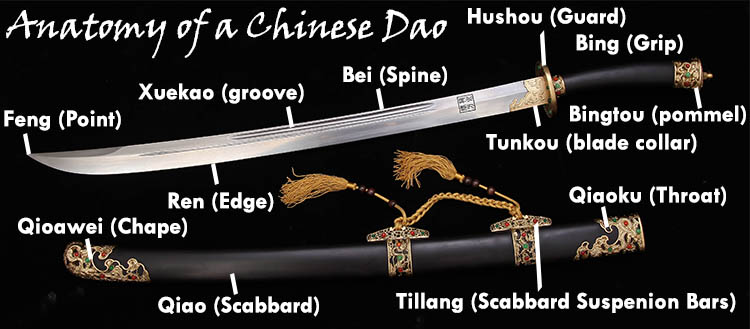 And the same thing for a Forge Direct Dao or 'Chinese Broadsword'
And the same thing for a Forge Direct Dao or 'Chinese Broadsword'The blades of these early period swords tended to be quite broad, extending with edges running parallel until they terminated abruptly in a very serviceable point, and were well balanced between cutting and thrusting.
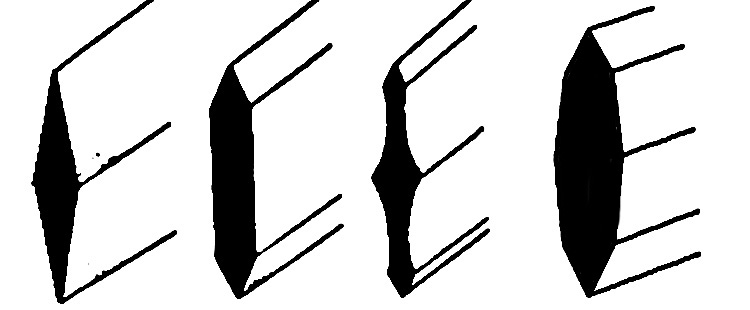 From left to right: diamond profile, hexagonal profile, hollow ground hexagonal profile and octagonal cross section.
From left to right: diamond profile, hexagonal profile, hollow ground hexagonal profile and octagonal cross section.In addition to quite advanced and innovative forging techniques, these early swords had very complex cross sectional blade geometries to strengthen the blades and reinforce the edges and the tip that were well ahead of their time.
Indeed, even in the Han period - there arose a specialized class of swordsman and swordsmanship was pursued by the aristocratic warrior-scholar class that was to become the elites of Chinese society.
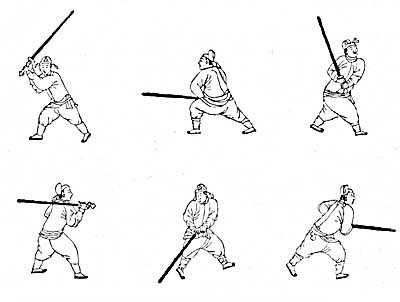
Over the next centuries, Chinese swords were increasingly refined, becoming lighter and more narrow - while techniques both graceful and deadly evolved along side them in harmony - with both sword and the art form becoming true art forms.
VIDEO: Chinese Swordsmanship Demo by Master Yu Cheng Hui
Practical Gongfu Style Swords
Chinese swords can be roughly divided into two types, the Jian - a straight bladed sword used for cutting and thrusting - and the Dao, a single handed saber like dedicated cutting blade - both of which were highly developed by the 2nd century AD.
Most people in the know who are looking for a practical Chinese Gongfu blade on a budget recommend the Hanwei Forge.
While in recent years they scaled back their bold roll out into this market, when the tide came back in it left some solidly made, very effective cutters on the shores for the picking.
They might not be very elegant, but they are very practical - be it for the practitioner of Tai Chi who is looking for something better than the typical $20 Chinatown special or the Gongfu practitioner after a Jian or Dao with an actual, cutting blade..
DISCONTINUED/UNAVAILABLE
Hanwei Cutting Jian
Designed by Sifu Scott Rodell THIS is the must have budget Jian for every CMA practitioner.

DISCONTINUED/UNAVAILABLE
Hanwei Practical Tai-Chi Sword
Not just for Tai-Chi, this is actually a pretty good entry level Jian.

DISCONTINUED/UNAVAILABLE
Hanwei Chinese Broadsword
Awesome cutting blade with a rewarding ringing sound when it hits a target.

DISCONTINUED/UNAVAILABLE
Hanwei Ox-Tail Dao
Great cutter with attractive fittings at a good price = happy customers.

While the current Chinese Swords in Hanwei's line up are rather function over form orientated, this wasn't always the case. To see some of the more attractive and advanced swords they introduced to the sword market that have since been discontinued, click here
In addition to swords for martial artists, Hanwei also produce a few historical pieces (they actually once had quite a few ancient historical pieces on offer, but due to a shrinking sword market generally, have all since been discontinued).
One of their most famous models that is still in production is based on the Chinese War Swords of the 19th century used to great effect during the boxer (read - martial artist) rebellion and uprising.
These were the final evolution in the history of Chinese swords, much like sabers were in the West, and while there are a few other replicas out there, this one is the cheapest of any battle ready version - though as is usually the case - you do only get what you pay for..
DISCONTINUED/UNAVAILABLE
Hanwei Da-Dao
Chinese Warsword with some serious attitude.

Chinese Beaters
Now these are swords with a more 'mass market' appeal. Generally speaking, serious martial artists don't like them too much because they tend to be overbuilt and too heavy. But the qualities that turn martial artists off seem to appeal to more casual collectors.
The most well known Chinese beater would have to be the Gim Sword by Cold Steel. Big, mean and incredibly durable and fearsome, the Gim (Cantonese for Jian) is a fantastic blade for the price - a highly attractive sword that can cut like no-ones business..
Cold Steel Gim Sword
If you want it for martial arts, forget it. But otherwise, you might end up falling in love with it. $299.95

Dynasty Forge Liuyedao
Less beater and more suited to CMA use, it's a good value attractive functional piece. $400

Ryujin Kiangxi
A short, brutal 'horse cutting' blade, it's ornately decorated and very effective. Great value. $179 |
Budget Yong Lo Sword
Tough 1060 carbon steel blade and stunning fittings. Looks much more expensive than it is.. $174.99

A Peek at High End Chinese Swords..
The REAL action for Chinese swords begins well above the $1,000 price point (and like Japanese swords, can at times go into the millions of dollars depending on both the smith and the individual sword)..
The best swords are made by certified Chinese Master Smiths with lineages going back into the mists of time and forging traditions and techniques that have created some of the most amazing looking and performing blades that have EVER been seen..
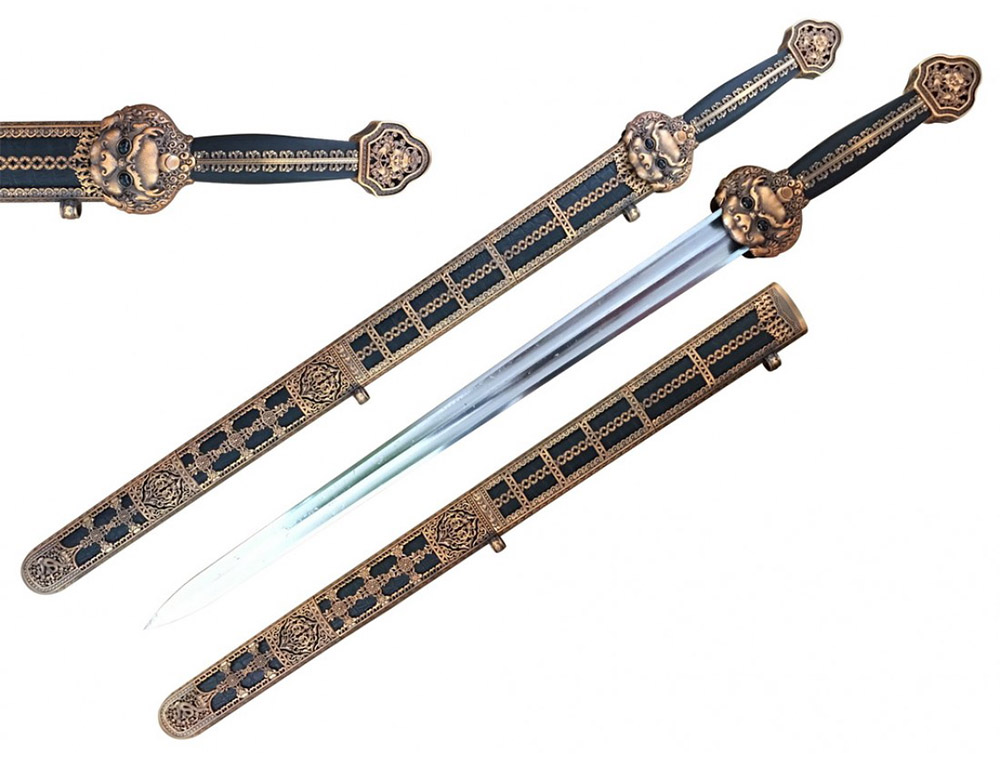
One sword that I feel best represents the world of high end is the so called 'Yong Lo Sword' - a Ming Dynasty Sword gifted by
the Emperor to a Tibetan Monastery and now on display at the Royal
Armory in Leeds.
From $200 to $10,000 and up,this has had many replicas and incarnations - to get the full lowdown, click here
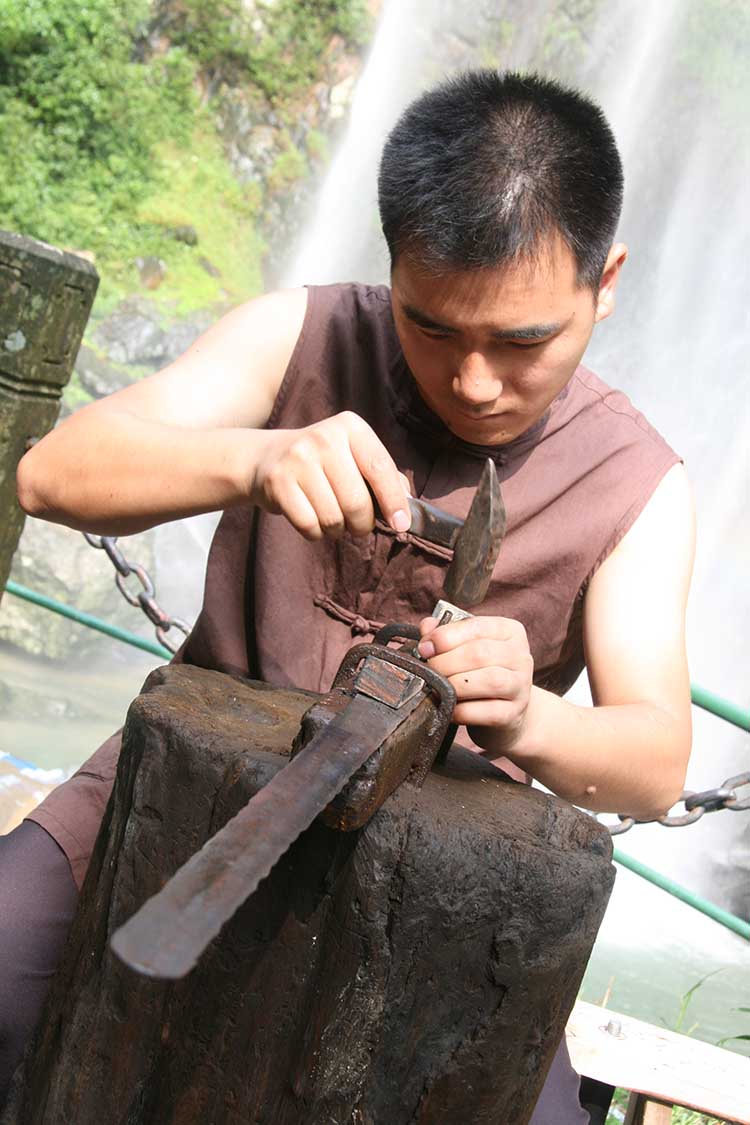 Master Xiaolong Jiang
Master Xiaolong JiangTo most people, this high end world is shrouded in mystery, but on a recent trip to Longquan China to see production of Japanese and medieval swords, I was personally introduced to this world and my fascination continues to grow the more I learn of it..
Over the years we have dipped out toe into the world of Master Smith made blades, though at a more modest price point with blades made by rank 2 smiths (there are basically four ranks of sword makers in Longquan - apprentice smiths, who do almost all the work, rank 1 Master Smiths, who are relatively common, rank 2 smiths who are much less common and rank 3 - world class national treasure)..
Here's the (now unavailable limited edition) sword we made in conjunction with a 2nd rank smith, Master Xiaolong Jiang called the Jian of Marquis Yi with unique folded octagonal geometry profiled blade and antiqued brass fittings.
Jian of Marquis Yi
The only problem that we see with buying these high end Chinese swords from other places is that proving who made them can be difficult and some of the Master smiths only run the forges, they retired from actual forging as soon as they took over a factory but are still happy to have their makers mark on a sword one of their senior apprentices made..
This is why it is critically important when buying high end Chinese swords to ensure you buy from the right vendor, as you are buying the reputation as much as you are buying the sword, and if you buy from unscrupulous dealers without knowing any better, you are almost certainly going to be short-changed or totally ripped off..
Don't let this put you off from looking at the high end - just be extra vigilant and make sure you only buy from a dealer that you know is 100% trustworthy. And you can enter a world of extremely unique rarified modern heirloom quality blades, but only if you are extra careful..
The Middle Ground
Recently some companies have been trying to bridge the gap between beater Chinese swords and the high end stuff. The most successful to date is LK Chen, whose work is so well regarded he is finding it hard to keep up and refuses to overload and damage his QC and in many ways reminds me of 'JinShi'.
Flying PhoenixYou'd think with a tip like that, it would be a thrusting sword. And while it sure can thrust, you should see it cut. Nearly perfect.. $458 |
Further Resources
The very best source for information on Chinese sword training and general information on the subject is Scott Rodell's Great River Taoist Centre Forums which includes further reviews, sword training, test cutting, maintenance and much more. High recommended and very informative.
You can also see some examples of antique Chinese swords and more information on their history at Thomas Chen's website here
Archived Reviews
I hope this information on Chinese Swords has been helpful. To return to the Sword Buyers Guide's Homepage, from Chinese Swords, click here

Buying Swords Online Can Be DANGEROUS!
Find the Best Swords in the:
Popular & Recommended ARTICLES

The ONLY true free online magazine for sword enthusiasts. Delivered once a month on the 1st day of the month, no filler and no BS, just the latest sword news & info delivered straight to your inbox.

